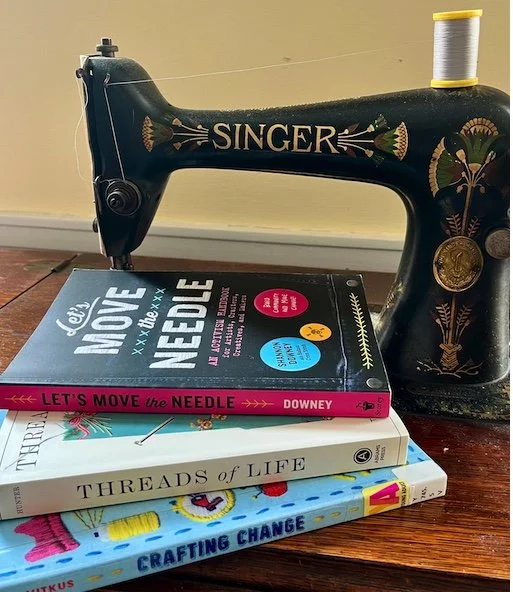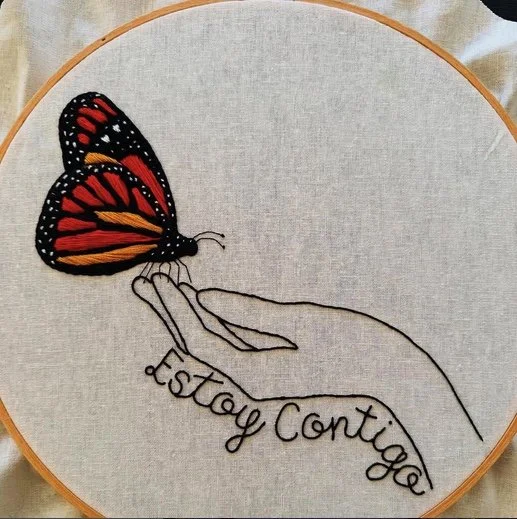Designed for Our Times: Books to Get Your Creative Juices Flowing Toward Justice
By Ruth Ann Smalley
Threads of Life: A History of the World Through the Eye of a Needle, by Clare Hunter
Let’s Move the Needle: An Activism Handbook for Artists, Crafters, Creatives, and Makers, by Shannon Downey
Crafting Change: Handmade Activism, Past and Present, by Jessica Vitkus
Sometimes small acts of creation–and even mending–can do more to uplift, empower, and repair than you might imagine. Especially if done in the spirit or company of community. Each of these books looks at the power of craft from a slightly different angle, but all offer fascinating examples, compelling stories, and inspiring models of human handiwork.
The first, as its title suggests, is a broad look at needlework through time and space. Clare Hunter is a community textile artist with lived experience of the power of sewing in a range of social settings, from psychiatric hospitals to protest encampments. Engagingly written, the book brings sensitivity, scholarship, and a deep appreciation of craft to the subject.
Hunter takes a sweeping look through history, from the politically-coded embroidery made by Mary Queen of Scots while imprisoned, to the story cloth embroideries of oppressed ethnic groups in Asia. She looks at the impact of colonialism, war, and modernization on the traditional patterns of Scottish kiltmakers, as well as Ukrainian and Palestinian embroiderers. She considers the function–whether therapeutic, artistic, or toward political expression–of sewing for prisoners and prisoners of war, disabled soldiers, marginalized or oppressed communities, and social activists. Organized around chapter headings such as Power, Frailty, Captivity, Identity, Journey, Protest, Threads of Life kept me spellbound by stories from all over the world, and eager to learn more about the many lives she recounts.
Let’s Move the Needle works as a handbook, one that centers the possibilities for activism Hunter’s book illustrated in the banners of the women’s suffrage movement or the British anti-nuclear protestors at Greenham Common. Downey, also known as Badass Crossstitch, brings her strong personal voice and verve, and her years as an organizer to the task of helping others become involved in “craftivism.” She favors embroidery for accessibility of the materials, and the ease of teaching it to others.
(photo from @badasscrossstitch, Instagram)
In Downey’s words, “Craft is the greatest tool I’ve ever stumbled upon for building communities and mobilizing them to take actions that will bring about actual social change. In fact, I call myself a community organizer disguised as a fiber artist. I trick people into hanging out together by promising embroidery workshops, and what we actually do is have community gatherings where we identify and find ways to work toward common goals” (9).
The book is full of examples, tips, and guidelines for developing your understanding and skills, using craft as a vehicle for positive change. Downey’s list of categories for the work craftivism can do is impressive and thought-provoking. Among them: Healing, civic engagement, education, awareness, boycott, community building, coded message sharing, challenging narratives, storytelling, record keeping, resistance, skill sharing, resource building (19). She highlights projects such as the refugee and immigrant-related Stitch Buffalo and Welcome Blanket project, and the Social Justice Sewing Academy.
Written for young readers, Crafting Change offers profiles of many inspiring projects and crafters (including Shannon Downey), across a range of mediums, including embroidery, knitting, quilting, photography, sculpting, baking, and zines.
From early anti-slavery quilters, to the ongoing AIDS Memorial quilt, to the modern teens designing quilts in the Social Justice Sewing Academy, you’ll find people taking up needles, paints, and other crafts individually, and in groups. You’ll see examples of clinical psychologist Melissa Blount’s Breonna postcards project and Black Girl Magic Portraits (Blount also worked on the Transgender Lives Matter Witness Quilt.
(photo from @badasscrossstitch, Instagram)
You’ll learn about artist Cara Levine’s ongoing “This is Not a Gun” project. Together, Levine and workshop participants create their own depictions of objects such as a hairbrush, a toy truck, a candy package, that civilians–typically people of color–were holding when shot by police on the pretext of having a gun.
These projects are clearly doing the work of healing, reflection and understanding, and identity/allegiance sharing that Downey names. I suspect that regardless of whether you identify as a crafter, activist, or craftivist, you will find inspiration and hope in the messages these books convey.
View all the Coop Scoop Blog posts here.



